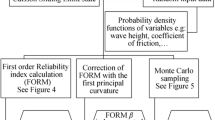Abstract
A new method of treating maximum wave height as a random variable in reliability analysis of breakwater caissons is proposed. The maximum wave height is expressed as the significant wave height multiplied by the so-called wave height ratio. The proposed wave height ratio is a type of transfer function from the significant wave height to the maximum wave height. Under the condition of a breaking wave, the ratio is intrinsically nonlinear. Therefore, the probability density function for the variable cannot be easily defined. In this study, however, it can be derived from the relationship between the maximum and significant waves in a nonbreaking environment. Some examples are shown to validate the derived probability density function for the wave ratio parameter. By introducing the wave height ratio into reliability analysis of caisson breakwater, the maximum wave height can be used as an independent and primary random variable, which means that the risk of caisson failure during its lifetime can be evaluated realistically.
Similar content being viewed by others
References
Battjes, J. A. and Groenendijk, H. W., 2000. Wave height distributions on shallow foreshores, Coast. Eng., 40(3):161–182.
Goda, Y., 1973. A new method of wave pressure calculation for the design of composite breakwaters, Rept. Port and Harbor Res. Inst., 14(3): 59–106. (in Japanese)
Goda, Y., 2000. Random Seas and Design of Maritime Structures, 2nd ed., World Scientific, New Jersey, USA.
Goda, Y., 2003. Revisiting Wilson’s formulas for simplified wind wave prediction, J. Waterw. Port Coast. Ocean Eng., ASCE, 129(2): 93–95.
Kim, D. H., 2014. Risk analysis of breakwater caisson under wave attack using load surface approximation, China Ocean Eng., doi: 10.1007/s13344-014-0082-8.
Klopman, G., 1996. Extreme Wave Heights in Shallow Water, Report H2486, WL/Delft Hydraulics, The Netherlands.
Longuet-Higgins, M. S., 1952. On the statistical distributions of heights of sea waves, J. Mar. Res., 11(3): 245–266.
Méndez, F. J. and Castanedo, S., 2007. A probability distribution for depth-limited extreme wave heights in a sea state, Coast. Eng., 54(12): 878–882.
Nagao, T., 2002. Reliability Based Design Method for Checking the External Safety of Caisson Type Breakwaters, Res. Report of Nat’l. Inst. for Land and Infrastructuer Management, 4.
Nath, J. H. and Ramsey, F. L., 1976. Probability distribution of breaking wave heights emphasizing the utilization of the JONSWAP spectrum, J. Phys. Oceanogr., 6(3): 316–323.
U.S. Army Corps of Engineers, 2006. Coastal Engineering Manual, U.S. Army Coast. Eng. Res. Center, Washington, D.C., USA.
Author information
Authors and Affiliations
Corresponding author
Additional information
This work was supported by the Korea Institute of Energy Technology Evaluation and Planning (KETEP) grant funded by the Korea Government Ministry of Knowledge Economy (Grant No. 20123030020110).
Rights and permissions
About this article
Cite this article
Kim, D.H., Kim, T. Probabilistic distribution of the maximum wave height. China Ocean Eng 28, 579–586 (2014). https://doi.org/10.1007/s13344-014-0079-3
Received:
Revised:
Accepted:
Published:
Issue Date:
DOI: https://doi.org/10.1007/s13344-014-0079-3



